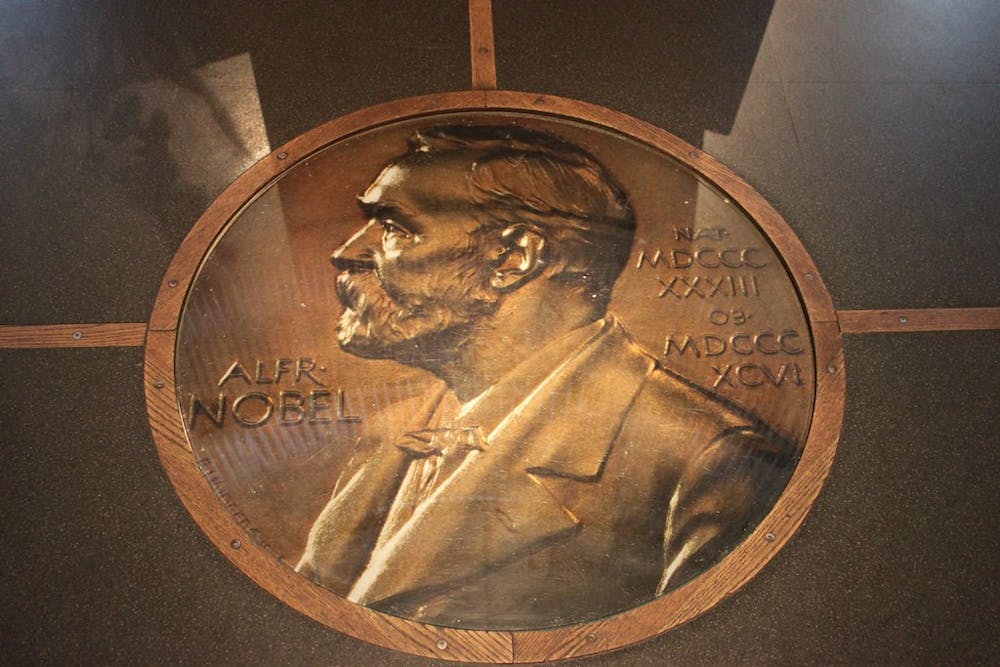For many of us, this past week was marked by late nights studying for midterms and catching up on work in Brody Learning Commons. Yet, for the global scientific community, it was marked by the announcements of the 2023 Nobel Prizes! Given annually since 1901 by the Royal Swedish Academy Of Sciences, Norwegian Nobel Committee, Nobel Assembly at Karolinska Institutet and Swedish Academy, the Nobel Prizes seek to reward discoveries that have profoundly advanced human knowledge or accomplishment in the fields of physics, chemistry, medicine, literature, peace and economic sciences.
Presented below are brief introductions to this year’s honorees in physics, chemistry and medicine.
The Nobel Prize in Physics 2023
The Nobel Prize in Physics 2023 was jointly awarded to French physicists Pierre Agostini and Anne L’Huillier as well as Hungarian-Austrian physicist Ferenc Krausz “for experimental methods that generate attosecond pulses of light for the study of electron dynamics in matter.” Their breakthrough discoveries opened up a new realm of scientific exploration: attosecond physics.
The subatomic realm operates remarkably quickly, with interactions between electrons taking place on the attosecond timescale — one billionth of a billionth of a second. While lasers enabled 20th-century physicists to measure the movements of entire atoms, it was impossible to measure subatomic events due to their fleeting nature. This year’s honorees enabled scientists to explore this new realm.
In 1987, L’Huillier demonstrated that it was possible to create overtones — additional wave cycles introduced on top of the wavelength of light — by passing an infrared laser through a noble gas. This phenomenon, caused by interactions between the electrons bound to the gas’ atoms and the laser, allows for the creation of shorter wavelengths than were previously thought capable of being generated. By superimposing these waves onto each other, it is possible to create attosecond pulses. This was done experimentally by Agostini and Krausz, enabling physicists to study electron movements.
These results have already been used to develop molecular fingerprinting techniques and have the potential to serve as a diagnostic tool for detecting cancer in blood samples.
The Nobel Prize in Chemistry 2023
The Nobel Prize in Chemistry 2023 was jointly awarded to American-Tunisian-French chemist Moungi Bawendi, American chemist Louis Brus and Russian physicist Alexei Ekimov "for the discovery and synthesis of quantum dots."
Quantum dots are nanoparticles which, due to their size, are directly influenced by quantum effects. Ekimov and Brus independently synthesized the first size-dependent quantum dots in the 1980s, creating materials that vary in their characteristics — such as light absorption — in accordance with their size. In the case of Brus’ experiment, the wavelength of light emitted by the particle varied from blue for the smallest particles to red for the largest.
While Brus and Ekimov were the first to synthesize these materials in 1993, Bawendi — who began his career as a postdoctoral under Brus — enabled mass production of quantum dots by saturating a solvent, forming cadmium selenide within it and varying the temperature to produce crystals with quantum behaviors.
Quantum dots now form an integral component of modern technology, found in applications ranging from computer displays and LEDs to tracking tumors in the body and serving as chemical catalysts.
The Nobel Prize in Physiology or Medicine 2023
The Nobel Prize in Physiology or Medicine 2023 was jointly awarded to Hungarian-American biochemist Katalin Karikó and American physician Drew Weissman “for their discoveries concerning base modifications that enabled the development of effective mRNA vaccines against COVID-19.”
In the 1990s, Karikó and Weissman were interested in how different forms of RNA impact the immune system, particularly the transcribed messenger RNA (mRNA). Performing experiments on dendritic cells, they recognized that in vitro transcribed mRNA was recognized as a foreign substance by the immune system but mammalian mRNA was not. This led the pair to the discovery that mammalian cells chemically modify the mRNA they produce, adding a base modification that removes the inflammation provoked by the foreign mRNA. Not only did inflammation cease, but cells that received base-modified mRNA increased protein production due to the deactivation of a protein production regulator.
By 2010, mRNA vaccines were being developed for several diseases, but it was with the COVID-19 pandemic that mRNA vaccines proved vital. The technology enabled the rapid production of multiple vaccines which were authorized for public use in December 2020. The speed afforded by mRNA vaccines is unmatched by weakened pathogen vaccines and is estimated to have saved millions of lives.
In addition, Norwegian writer Jon Fosse was awarded the Nobel Prize in Literature 2023 “for his innovative plays and prose which give voice to the unsayable” and Iranian Activist Narges Mohammadi received the Nobel Peace Prize 2023 for “her fight against the oppression of women in Iran and her fight to promote human rights and freedom for all.” The Sveriges Riksbank Prize in Economic Sciences in Memory of Alfred Nobel 2023 was awarded to American economic historian Claudia Goldin “for having advanced our understanding of women’s labour market outcomes.”





